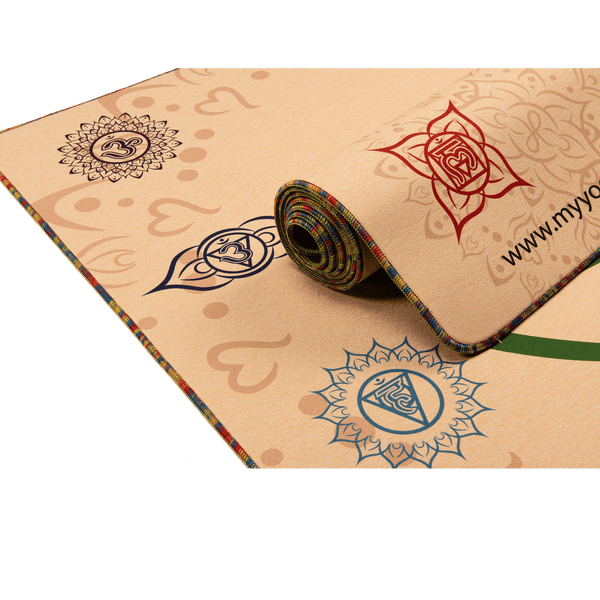How to Choose a Yoga Mat
Not all yoga mats are created equal — which is why it can be challenging to choose the one that's right for you! They come in a wide range of prices, not to mention sizes, thicknesses, colors, materials, and even shapes. With all these options, how do you start narrowing it down?
Beginning yoga students sometimes make the mistake of buying the first cheap mat they see online or at a department or sporting goods store. A low-quality mat can actually hinder your practice: if it's uncomfortable or too slippery, you may have a hard time getting into or maintaining poses, which will make the whole experience more difficult and less enjoyable.
It is important to choose a mat carefully. A high-quality mat can last for several years or even longer, while a low-quality one may get destroyed within a few months of regular use. Think about how you intend to use it and any unique considerations you have regarding comfort or preference.
Here are a few things to keep in mind when choosing a yoga mat.
How Will You Use It?
Consider whether your mat will stay at home, or if you will be taking it back and forth to class. A large, heavy mat can become a hassle if you're carrying it around a lot; likewise, a round mat doesn't transport as well as a traditional rectangular mat that can be rolled and put in a carrying case or tied with a strap or sling. If you intend to travel around the country or around the world, you might want an especially lightweight mat that doesn't take up much room in your suitcase.
How Thick Should It Be?
Standard thickness is 3mm (1/8"), and you may find this more comfortable than you think! Travel mats may be as thin as 1.5mm. While they don't give you a lot of cushioning, they still provide the grip you need while practicing yoga, and they're much easier to travel with!
You may also find mats that are 4, 5, and 6mm thick. Those thickest mats offer a lot of cushioning, so if you find it hard to kneel or lie down, it might be more comfortable in that sense. However, they are heavier and bulkier to carry to and from a class, and the thickness can make it harder to balance. If you do restorative or yin yoga, a thick mat may be preferable since balance isn't as much of a concern.
Do You Need Extra Length?
A standard mat is 24" wide and 68" long, though they do come in a variety of lengths and widths. In general, it's not a big deal if you have a hand or a foot off the mat, and in some poses, you might anyway — even if you go for a larger mat. Still, if you're especially tall, it might be nice to have the extra length. Just as with thickness, you should consider the extra bulk of a longer or wider mat and whether that interferes with how you carry it to class.

What Should It Be Made Of?
Mats come in a variety of materials, including rubber, cork, and more. These options are wonderful; years ago, it was hard to find a mat that wasn't made of PVC, which we now know is a toxic plastic. Not only is it difficult to recycle, but exposure to it may cause health issues. PVC mats are still available, but with so many alternatives, it's easy to choose an eco-friendly mat that still offers superb grip, cushion, and additional benefits.
Take a look at the characteristics and benefits of some of these popular yoga mat materials:
Rubber
Natural rubber mats do contain latex; if you have a latex allergy, you should avoid rubber. Otherwise, rubber mats offer fantastic grip and comfort, and they're also recyclable.
TPE
TPE stands for thermoplastic elastomer. This material is generally recyclable, and it requires less energy to produce in the first place. It's also hypoallergenic! You'll find your TPE mat to be durable and long-lasting, lightweight, and super-sticky. It doesn't absorb moisture, so if you use it for hot yoga you can simply wipe that sweat away.
Cork
These durable mats have a soft, earthy feel. They actually get stickier as they get damp, which makes them great for hot yoga. Since it offers a porous surface, the sweat won't pool. Cork is naturally antibacterial, so it's easy to clean: simply wipe away dirt and oils with a damp cloth; dampen that cloth with vinegar for a deeper clean. Furthermore, cork is a sustainable material. Cork trees are not cut down to produce mats or other cork products. Instead, the cork bark that is taken from the tree grows back!
Cork mats typically have a rubber backing, so they are made of two layers. They're a little harder to roll than some other types of mats, so a yoga mat strap is easier to use than a bag for carrying purposes.
Suede or Linen
Your TPE or rubber mat can also be layered with hemp linen or suede. Microfiber suede is soft and it absorbs sweat — it will get stickier as it gets wetter. Hemp linen offers another durable and eco-friendly option for the top of your yoga mat.
After comfort and eco-friendly considerations, it's time for the fun part! Mats come in a variety of colors and designs, so you can choose one that feels enjoyable and uplifting to you. After all, you'll be looking at it almost every day—right?
How to Care for Your Mat
Many mats today are built to last, and you can extend its life, even with regular use, with a few care tips. If you're going to be taking your mat from home to the studio, a mat carrying case or sling is helpful. The case protects the mat from dirt and debris; the sling or strap at least allows it to stay rolled carefully when you put it down or if you were to drop it.
Gentle cleaning is typically all that's required, especially if you have an anti-microbial mat. Use a soft cloth and water or a mixture of vinegar or essential oil to wipe it down. Let it dry before rolling it, and store it carefully when you're not using it.
Over the course of your yoga journey, your mat needs and preferences may shift. No matter which mat you choose, you can look forward to an exciting and rewarding adventure with your yoga practice!
At My Yoga Essentials, we have a wide variety of beautiful, high quality and functional yoga mats you may choose from.
- Our TPE mats are eco-friendly and budget friendly, anti-microbial, hypo-allergenic and lightweight. These are great all around mats.
- Our hemp linen and natural rubber yoga mats are both stylish and eco-friendly and come in both a mandala design as well as a chakra design.
- Our beautiful and 100% recyclable cork yoga mats contain zero PVC's and no harsh chemicals. Whichever cork mat you choose you choose, you can't go wrong. See our cork mats here.
- Our suede and natural rubber yoga mats come in a variety of styles and at only 1.5 mm thick these yoga mats can be used alone, or layered over another mat for extra softness and absorption. Choose from our Yogi With Chakra design, our It Just Blooms design or our Ganesha inspired mats for your next workout.
We have a 100% satisfaction guarantee and a variety of money saving yoga mat bundles to choose from, so you can be both confident shopping with us and save money. The perfect combo in our opinion!
If you've enjoyed this post, or have ideas for future blogs, we'd love to hear from you! Send us your thoughts, or better yet, become a guest blogger. Submit your ideas and we'll get back to you with guest blogger requirements.


